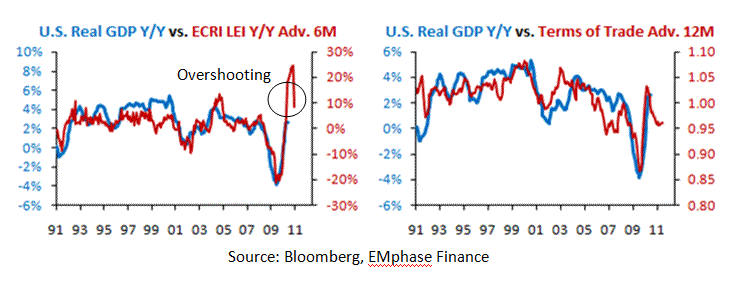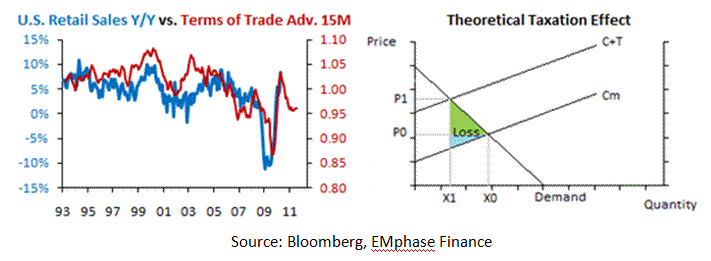Terms of Trade Superiority at Forecasting U.S. Real GDP!
Economics / US Economy Jun 26, 2010 - 04:18 PM GMTBy: Francois_Soto
 ECRI Weekly LEI Issue
ECRI Weekly LEI Issue
Many market participants are debating whether or not a double dip recession will occur within the next quarters. As we are writing our report, ECRI Weekly LEI fell quickly to 122.5 points from 134.7 in April. This indicator did a good job leading U.S. Real GDP Y/Y by 6 months over the last two decades. However, ECRI Weekly LEI recently became quite unreliable as it increased up to 25% Y/Y in April, a level consistent with an unrealistic 8% U.S. Real GDP Y/Y! You can notice the problem on the left chart below.

We discovered a new leading indicator to forecast U.S. Real GDP Y/Y and it is simply the U.S. Terms of Trade (TOT). It is defined as the export price / import price ratio. We are pleased to be the first to document this, at least publicly. On the right chart above, TOT leads U.S. Real GDP Y/Y by 12 months. The only drawback: underlying time series are monthly instead of weekly but this is not really an issue with that much lead. Also, the relationship still holds well if we extend to the maximum data (1985).
TOT Rationale
At this point, you are probably wondering the rationale or logic behind TOT. Effectively, the relationship is highly counterintuitive but we proceeded with two tests. First, we calculated international TOTs for ten developed countries and we concluded this relationship only works with the United States. Second, we calculated the export price / import price ex petroleum ratio and we found this relationship vanish under this new ratio. This means crude oil priced in U.S. dollar is crucial to explain why this works.
Jonathan Tepper of Variant Perception, a UK based research firm, provided a great explanation: "Demand for crude oil is highly inelastic and the U.S. is almost entirely a crude oil importer. Whenever crude oil price increases, U.S. consumers absorb it no matter what. Crude oil price increases either because of the fundamental demand, speculative demand or simply because U.S. dollar declined and more U.S. dollars are required for a same barrel of oil. U.S. consumers perceive this as an indirect form of taxation that reduces their willingness to consume as they have less discretionary income available."
The left chart displays the direct relationship of TOT with U.S. Retail Sales Y/Y. Here is another way to explain: When crude oil price increases, import prices increases, this deteriorates TOT and the wealth loss appears on the right chart. We could also say this effect is broader than just the crude oil tax effect. For example, if U.S. dollar decreases, imported goods become expensive as well so we see a double effect: indirect tax and less affordable imported goods. Corollary of this relationship applies as well.

Why TOT only work in the U.S.? We identified two reasons. First, the U.S. is one of few countries where personal savings as % of disposable income are so low (3.6% as of June) that consumption benefits are nearly direct to U.S. Real GDP. If U.S. consumers begin saving more, this will create an economic environment with lower growth and may impair the leading quality of TOT. However, this hypothetical scenario has yet to materialize. The second reason why TOT works exclusively in the U.S. is because crude oil is priced in U.S. dollars and is therefore only relevant to U.S. figures and not any kind of international TOTs. As long as the U.S. dollar remains the official international currency, it will work.
Why TOT leads both U.S. Real GDP Y/Y and Retail Sales Y/Y by 12 months and 15 months respectively? It is all a matter of perception. Perception happens before any form of consumption. We will answer this question indirectly with an example. As you all know, with the significant quantitative easing done by the Fed, it took more than a year for market participants to recognize the impact of such a leviathan measure. If Wall Street is wiser than Main Street, don't be surprised if Main Street perception is more myopic and consequently less fast to adjust to economic environment changes such as either an increase or a decrease of social wealth. This is the best explanation for the significant TOT lead.
TOT Forecast
As you probably noticed earlier, TOT is suggesting a decline of U.S. Real GDP Y/Y to nearly 0% within the next 12 months. Q2 2010 Real GDP Q/Q Annualized to be released on the 30th July may match expectations as it reflects data of the last three months which were positive in general. However, we are most likely going to see weaker numbers in the next quarters. Will this lead to a double dip recession? We believe odds of a double dip recession within the next 9-12 months is minimal but odds may increase to 50-50 in 2011 depending on the evolution of variables we follow in the upcoming months.
A U.S. Real GDP Y/Y of nearly 0% in 12 months means it will remain around the same level as of Q1 2010 with little room for two quarters output decline. Second, our Rough Times indicator displayed in our U.S. Economics Monthly research does not foresee one yet. However, there are two compelling arguments in favour of a potential double dip recession. Every time crude oil price increased more than 100% in a year over the last decades, the U.S. always entered a recession. Finally, China announced earlier this week it would loosen its currency's peg to the U.S. dollar. An additional Yuan flexibility may boost crude oil demand and therefore making TOT worse than its current level and therefore raise recessionary odds.
About Us
Background
EMphase Finance is an independent investment advisor in the management of equity
portfolios for both private and institutional clients. More information: www.emfin.com
Contact
François Soto, Chief Investment Strategist of EMphase Finance, fsoto@emfin.com
300 Ave. Des Sommets, Suite #1213, Montreal, QC, Canada, H3E-2B7, 514.984.9155
Pricing
Annual subscription to one/first international or sectoral service = TBA
Annual subscription to 2nd & 3rd additional services = TBA
Annual subscription to 4th+ additional services = TBA
Consultancy service available upon request = TBA
Disclaimer
Accuracy of Information
This report is based on sources believed to be reliable or trustable and the information is provided without responsibility. However, EMphase Finance cannot guarantee its accuracy.
No Recommendation
This report is issued only for informational or educational purposes. This report doesn’t contain any solicitation from EMphase Finance to act as a securities broker or dealer in any jurisdiction.
No Responsibility
EMphase Finance will not be held responsible for any direct or indirect loss arising from any use of material included in this report and this to the full extent permitted by the law.
Copyright
This report is the property of EMphase Finance. Reproduction may be permitted only by written consent. The use of any content and charts for any purpose is strictly prohibited.
Sources
BB, BC, BEA, BLS, CB, CBO, CBOE, ECRI, FHFA, FRB, GOOG, GSCI, ISM, MBA, MC, NAHB, NBER, S&P.
By Francois Soto, President EMphase Finance www.emfin.com
© 2010 EMphase Finance. All rights reserved. EMphase Finance strives to become one of the most important website in North America concerning fundamental analysis using traditionnal quantitative and technical analysis based on the Elliott Wave Principle. The website will contain detailed analysises concerning specific companies, commodities and indexes along with educational content.
© 2005-2022 http://www.MarketOracle.co.uk - The Market Oracle is a FREE Daily Financial Markets Analysis & Forecasting online publication.



